|
|
Visit to Stonehenge in S. W. England
On the way to Stonehenge, we
noticed white figures sculptured into some of the surrounding farm land.
We asked the tour guide what the figures represented and why they were
white in appearance. She explained the symbols were done by local
farmers to display something of their heritage. The symbols are
white because most of the soil in Southern England is composed of decayed
sea shells, since this part of England was under water in pre-historic
times. When you dig below the surface top soil the ground is almost
white. In about an hour we arrived at Stonehenge and noted Stonehenge is in an area adjacent to a military reservation. It felt strange to be in this incredibly old place only to see and hear tanks and troops running around everywhere. It also seems all the earth shaking noise would damage Stonehenge in some way? However, once you go through
the visitor center and actually walk out to the park area it is very quiet
and, I have to say, startlingly stark. We have read about Stonehenge
all our lives and were awe struck to actually be able to see it in person. The area is roped off so you are not allowed to actually walk around among the stones. You can only see them from quite a distance. The tour guide told us a few religious groups are allowed access to the area among the stones for ceremonies at Summer Solstice. The sunrise of the Summer Solstice lines up with the "Heel Stone." Historians think the alignment of the sun during the solstice sunrise had some religious significance. WHEN was Stonehenge
built? Around 2600 BC Bluestones from Preseli Mountain in Wales (up to 4 tons each) were set up to form a double crescent in the center of the earthwork. This structure was eventually dismantled. The final structure was begun
around 2400 BC with the arrival of the sarsen stones Amazingly the lintel stones are held in place on the uprights with mortise and tenon joints and the stones appear to have been shaped before placement. For example, the lintels are shaped in the form of the circle where they were installed. HOW Stonehenge was
built is a mystery surrounded by a lot of scientific speculation. Unfortunately the structure
has not been completely preserved and a great deal of the site has been
vandalized over the years. Possibly some of the material was used
for local construction, since no stones of this size are available
anywhere near this area. The area around Stonehenge is dotted with Round Barrows, the burial mounds for people of the Early Bronze age. The burial mounds have been found in many forms and a great many of them have been destroyed by plows and other construction activities. More of these mounds are located here area than any other area in Great Britain. The area around Stonehenge is
a place we could have spent a lot more time looking around and studying as
well as asking a few thousand questions.
More details are available
from: We cannot wait to get back and have the time available to see this place again. |
||
|
|||


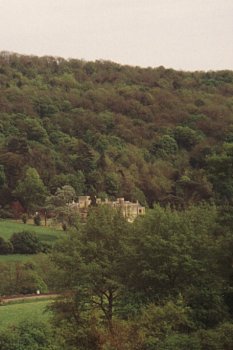 STONEHENGE
is Southeast of Bath close to Amesbury on the 303 highway. On the
way we left the hill country and moved back into farm land surrounding
beautiful little English villages. Also miles and miles of fields
covered with Rapeseed plants.
STONEHENGE
is Southeast of Bath close to Amesbury on the 303 highway. On the
way we left the hill country and moved back into farm land surrounding
beautiful little English villages. Also miles and miles of fields
covered with Rapeseed plants.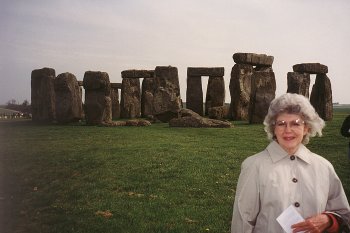
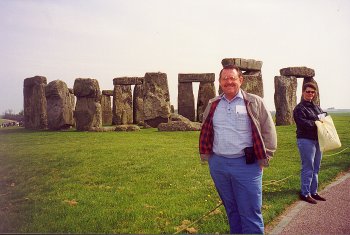
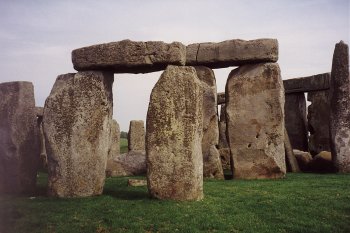 Construction may have begun about 3050 BC with the circular ditch,
embankment and counterscarp surrounding the current stone construction.
Evidence has been found showing timber settings were constructed inside
the earthwork between 2900 and 2600 BC.
Construction may have begun about 3050 BC with the circular ditch,
embankment and counterscarp surrounding the current stone construction.
Evidence has been found showing timber settings were constructed inside
the earthwork between 2900 and 2600 BC.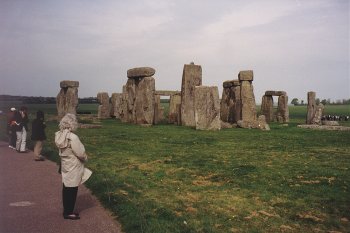 (over 50 thousand pounds each) from the Marlborough Downs 20 miles north
of Stonehenge.
(over 50 thousand pounds each) from the Marlborough Downs 20 miles north
of Stonehenge.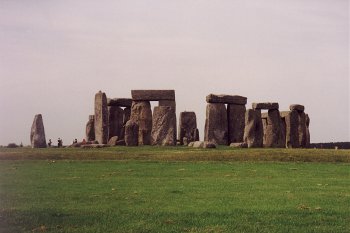 Construction would have required a tremendous labor force and certainly
was an incredible engineering accomplishment. The vertical supports
could have been raised with ropes and lots of labor and the lentils could
have been placed possibly using wooden structures.
Construction would have required a tremendous labor force and certainly
was an incredible engineering accomplishment. The vertical supports
could have been raised with ropes and lots of labor and the lentils could
have been placed possibly using wooden structures.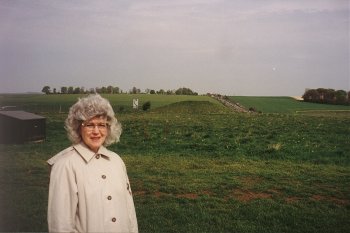
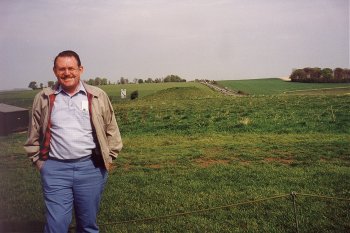 But,
the tour bus moves on, so off we went back to London after a wonderful day
in the Southwest English countryside.
But,
the tour bus moves on, so off we went back to London after a wonderful day
in the Southwest English countryside.